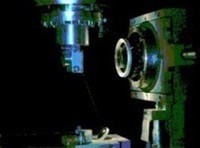
Ioannis ArvanitidisProfessor
Academic Field
Optics, Optical Properties of Solids and Solid State Spectroscopy
Courses
- General Physics IV (Optics - Waves) (CP 2012)
- Geometrical Optics - Applications (CP 2022)
- Geometrical Optics and Applications (CP 2012)
- Optics Laboratory (CP 2022)
- Optics Laboratory (CP 2012)
- Physics IV (Optics-Waves) (CP 2022)
- Solid State Physics (CP 2022)
- Solid State Physics Laboratory (CP 2012)
- solid state physics (CP 2012)
Laboratories & Divisions
Research Activity

By using spectroscopic techniques (Raman, IR, absorption, Photoluminescence) and the synergy of theoretical calculations (phenomenological models, first-principles calculations, group theory) the optical properties of a wide range of materials (semiconductors, fullerenes, carbon nanotubes, garnets, low-dimensional materials etc.) are studied. These techniques and theoretical methods are utilized for materials characterization (identification of polytypes and phases, crystallinity, presence of mechanical stress/strain, chemical functionalization, electronic doping etc.) as well as for the study of fundamental physical phenomena (electron-phonon interaction, Kohn anomalies, immediate neighboring interactions etc.).
Moreover, the influence of external perturbations (temperature, uniaxial or biaxial mechanical deformation, hydrostatic pressure, electrochemical doping etc.) modifies drastically the optical properties of a material providing, thus, information on the physical phenomena themselves and allows the investigation of structural stability and the study of pressure induced structural or electronic phase transitions of materials.
- Indicative activities:
- Study of optical properties under normal conditions, high pressure and as a function of temperature of materials such as semiconductors (ΙΙΙ-V, II-VI), fullerenes and related compounds, chemically modified carbon nanotubes and scheelite compounds (ABO4, Α = Ca, Sr, Ba and B = W, Mo).
- Study of the optical properties of two-dimensional materials such as graphene (single or multilayers), BN, transition metal dichalcogenides (MoS2, WS2, Mo1-xWxS2, MoSe2) as a function of their interaction with various substrates, physical or chemical electronic doping, mechanical deformation and hydrostatic pressure.
- Study of III-V nitrides (AlN, Gan, InN and their alloys) using Raman spectroscopy: effect of ion implantation and doping as well as of the stresses induced during the epitaxial growth.
- Lattice dynamics of the rare earth aluminum and gallium garnets in a crystal form and as solid solutions (RE3Al5O12 and RE3Ga5O12, RE=rare earth).
- Equipment:
- Raman and photoluminescence set-up consisted of a triple monochromator (DILOR ΧΥ) with gratings of 1800 lines/mm and a CCD (EG&G 1433-C) liquid-nitrogen-cooled detector.
- Raman spectrometer RAMALOG 5 equipped with a Peltier-cooled photomultiplier tube with GaAs photocathode and a triple-monochromator that covers the wavelength range 12000 – 28000 cm-1 (8500-3500Å), fully automated and PC controlled.
- Two Ar+ Lasers of Spectra Physics 2W.
- One Kr Laser of Lexel 1.5 W.
- One cryostat accompanied by a diffusion pump of Cryogenic that works down to 20 K.
- Gas membrane driven diamond anvil cells, micro-tensiometers for the application of mechanical deformation (uniaxial, biaxial).
RESEARCHERS

1) "Speckle phenomena": Relating to the properties (statistically) of light (partial coherence and coherence) and the statistics of surfaces where the light is reflected or refracted. Our research is concerned with "Speckle" interferometry issues and optical image processing with carriers the "grains" of "Speckle".
2) Optical Image Processing: This is based on a general view of the scalar theory of diffraction of light in classical optics, which is called Furrier Optics. Our operations are mainly concerned with the research of methods of observing phase objects (e.g. transparent materials with variable refractive index).
3) Photorefractive Crystals: In these crystals phase gratings may be recorded. These phase gratings are carriers of record, storage and optical image processing. In specific sections of these crystals gratings are recorded versus the orientation of vector grating and versus the high voltage that is applied at their ends. With incidence in the grating of a proper light beam, the recorded information is reproduced via diffraction. We study the diffraction efficiency of gratings and the polarization properties of the diffracted beam, in terms of the polarization state of the incident beam, and other properties of phase gratings.
4) Physical Properties of Crystals: Here we are dealing with crystals which are: electro-optic, (Pockel effect), photo-elastic (via the inverse piezoelectric effect), optical-active, shows linear electro-gyration effect, etc. Using specified optical experimental arrangements we measure: The dispersion (depending on the wavelength) in the visible region of the electromagnetic spectrum: a) The refractive indices of crystals, b) The optical activity, c) The electro-optical coefficients and d) The electro-gyration coefficients.
5) Integrated Optics: In the course of the years past, integrated optics promised an exciting breakthrough through the development of photonic chips capable of controlling the light in a plethora of applications expanding from biological or chemical sensors and optical computing up to data communications. The research is actively operating in the area of integrated optics towards the development of integrated transceiver modules, photonic data interconnects and electro-optic switches, Quantum Random Generators and biosensor devices. Starting from the design, the research activities extend up to the complete characterization of active/passive integrated photonic components, i.e. carrier depletion modulators, plasmo-photonic modulators, grating couplers, multimode interference structures, ring-resonator based devices, routing elements, de/multiplexers and waveguide phase arrays, optical interfaces for active/passive devices in several material platforms and technologies.
6) Plasmonics: Plasmonics is a rapidly developing field that studies elementary polar excitations bound to metal surfaces. Plasmonic technology offer a new class of components with enhanced optical performance at ultra-small footprints below the diffraction limit. Current research efforts focus on bringing plasmonics in wafer scale CMOS lines to demonstrate low-cost fabrication of compact modules in the ever-growing areas of data communications and bio-sensing. The research is engaged in the simulation and characterization of integrated, on-chip, low energy electro-optic switches, ultra-sensitive biosensors and ultra-compact, ultra efficient, high speed modulators for data center interconnects.
7) Optical Phase Arrays: Optical phased arrays (OPAs) have recently drawn significant research attention due to their promising capabilities of non-inertial optical beam forming and steering delivering a variety of 3D sensing, imaging, illumination, ranging and optical wireless links. By manipulating the specific spatial distribution of the amplitudes and phases emitted from individual optical antennas, OPAs can form the desired radiation patterns through far-field interference. The research field is extended to the simulation of OPAs towards the development of compact and low power integrated beam steering devices for hybrid switching systems combining active waveguide and free space optics. In parallel there is strong experimental activity related to the characterization of OPAS assembled with cylindrical lenses for beam steering.
Laboratory Infrastructure
1. Optical and mechanical systems controlled by PC
2. Optical components and systems
3. Sources of Light and Lasers
4. Electronic Systems (oscilloscopes, power supplies, etc.)
5. Monochromators, spectrometers
6. Full range of microscopes
7. Diffractometers, interferometers and other optical instruments
RESEARCHERS

Study of the nanostructure (nearest neighbor distances, coordination numbers and bond angles) as well as optical properties (density of unoccupied states) in the soft and hard x-ray spectral region using x-ray absorption spectroscopies EXAFS & NEXAFS.
Elemental mapping using the x-ray fluorescence spectroscopy (XRF mapping) and micro XAFS. The samples under study are:
i) compounds of Si (mainly SiNx)
ii) group III nitrides (GaN, AlN, InN and their alloys)
iii) glasses and glass ceramics containing solid wastes (information on the sample preparation can be found in the web page of WFENV-NET http://web.auth.gr/wfenv-net
iv) biological samples for the determination of the trace element concentration
Moreover, inelastic X-ray (and alternatively neutron) scattering for the study of dispersion curves and the density of states of crystalline solids can be conducted.
The measurements are conducted at Synchrotron Radiation facilities:
BESSY http://www.hasylab.de,
HASYLAB http://www.bessy.de,
ELETTRA http://www.elettra.trieste.it,
ESRF http://www.esrf.fr.
